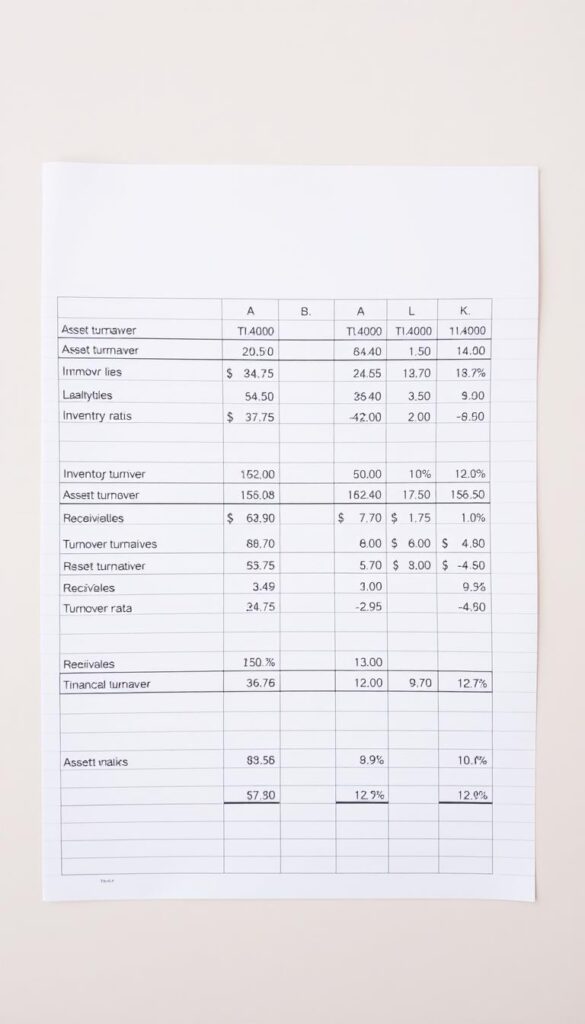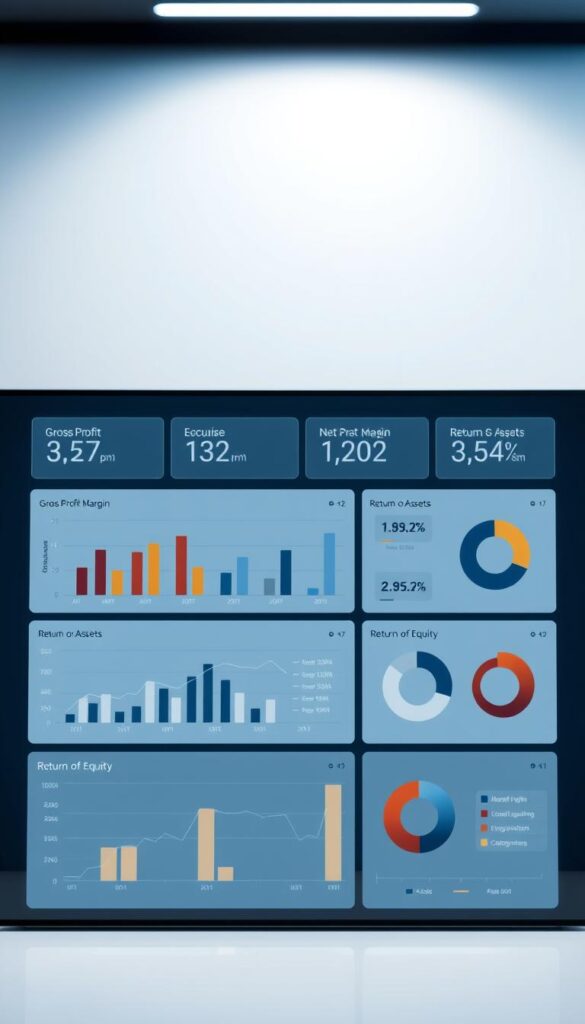Ever wonder why some companies do well while others struggle, even with similar money? Financial ratios might be the key. These tools are essential in accounting, helping to check a company’s financial health. By looking closely at these ratios, you can find important insights that change how you see financial success.
This article will cover the main financial ratios every accountant needs to know. We’ll use real examples to improve your financial analysis. By using numbers from important financial statements, you can check liquidity, profitability, efficiency, and leverage. Let’s explore the world of financial ratios to boost your skills in financial analysis.
Key Takeaways
- Financial ratios are vital for assessing a company’s performance over time.
- A current ratio between 1.5 to 3 is considered healthy for liquidity assessment.
- Numerical values from key financial statements are important for ratio calculation.
- Understanding various ratio categories can reveal a company’s operational efficiency.
- Real-life examples illustrate practical applications of these important ratios.
Understanding Financial Ratios
Financial ratios give us key insights into a company’s performance. They connect different financial data, helping accountants quickly see how a business is doing. These ratios show how well a company is doing, beyond just numbers.
By analyzing financial ratios, you can see how a company’s financial health changes over time. Ratios like the current and quick ratios are key for checking if a company can pay its short-term debts. For example, Company A has a current ratio of 2, showing it manages its cash well. Company B’s quick ratio of 1.5 means it can handle immediate debts without using inventory.
Profitability ratios, like gross and net profit margins, tell us about a company’s efficiency. Company C has a gross profit margin of 60%, showing it makes good money from its sales. This is different from Company D’s net profit margin of 16.67%. These numbers help us understand how a company performs compared to others in its field.
Debt ratios, like the debt-to-equity ratio, show how much debt a company has. Company E’s ratio of 0.67 means it has a moderate amount of debt compared to its equity. This ratio is important for understanding a company’s debt level.
Watching these ratios helps us make better decisions and see what’s working and what’s not in a company’s financial plan.
Importance of Financial Ratios in Accounting
Financial ratios are key tools for accountants and financial experts. They help track a company’s performance and check its financial health. By looking at these ratios, you can understand profitability, efficiency, and market value. This helps make better decisions.
Management uses these ratios to spot trends and make smart plans. Investors and creditors also look at them to see if their money is safe and if they’ll make a profit.
Understanding financial ratios shows what a business is good at and where it needs to get better. For instance, a good current ratio means the company can pay its short-term debts. The debt-to-equity ratio shows how much risk the company takes on. Both are important for planning the future.
In short, knowing how to use financial ratios is key to making smart choices and keeping a business strong over time.
![]()
| Type of Ratio | Importance |
|---|---|
| Current Ratio | Assesses short-term liquidity |
| Debt-to-Equity Ratio | Indicates leverage and risk |
| Gross Profit Margin | Measures profitability of core activities |
| Return on Assets | Evaluates efficiency of asset utilization |
| Interest Coverage Ratio | Shows ability to meet interest obligations |
Categories of Financial Ratios
Financial ratios are key to understanding a business’s financial health. They can be grouped into several types, each with its own purpose. This grouping helps in analyzing a company’s performance effectively.
The main categories include:
- Liquidity Ratios: These show a company’s ability to meet short-term debts. Examples are the Current Ratio and Acid-Test Ratio.
- Leverage Ratios: These look at a company’s debt levels compared to its equity and assets. The Debt to Equity Ratio is a key example.
- Efficiency Ratios: These check how well a company uses its assets to make income. Ratios like Asset Turnover Ratio and Inventory Turnover Ratio are important here.
- Profitability Ratios: These show how well a company makes profit compared to its costs. The Gross Margin Ratio and Operating Margin Ratio are examples.
Looking at these categories gives you unique insights for a thorough financial check. Knowing what each ratio means will improve your financial analysis skills.
| Category | Purpose | Examples of Ratios |
|---|---|---|
| Liquidity Ratios | Measure ability to meet short-term obligations | Current Ratio, Acid-Test Ratio |
| Leverage Ratios | Assess debt levels relative to equity | Debt Ratio, Debt to Equity Ratio |
| Efficiency Ratios | Evaluate asset utilization | Asset Turnover Ratio, Inventory Turnover Ratio |
| Profitability Ratios | Indicate profit generation capability | Gross Margin Ratio, Operating Margin Ratio |
Liquidity Ratios
Liquidity ratios are key to understanding a company’s short-term financial health. They show if a business can handle its short-term debts. Important ratios include the current ratio, quick ratio, and cash ratio. Each is calculated differently to measure liquidity well.
Current Ratio Explained
The current ratio shows if a company can pay its short-term debts with its current assets. It’s calculated as: Current Ratio = Current Assets / Current Liabilities. A ratio between 1.2 and 2.0 is usually good, showing enough assets to cover debts.
If the ratio is over 1, it means the company can likely meet its financial duties. But, a lower ratio might show problems.
Acid-Test Ratio Overview
The quick ratio, or acid-test ratio, looks at the most liquid assets, excluding inventory. It’s calculated as: Acid-Test Ratio = (Current Assets – Inventories) / Current Liabilities. A ratio of 1.0 or more shows strong short-term financial management.
This is because it doesn’t rely on inventory sales, which can change a lot.
Cash Ratio Calculation
The cash ratio is the most conservative measure. It looks at cash reserves against current liabilities. The formula is: Cash Ratio = Cash and Cash Equivalents / Current Liabilities. A higher ratio means better financial stability, which is important in tough times.

Leverage Ratios
Leverage ratios are key indicators that show how much a company relies on debt. They help spot financial risks and guide important decisions. By looking at these ratios, you can see how well a company uses debt to grow and operate.
Debt Ratio Insights
The debt ratio shows what part of a company’s assets are financed by debt. It’s found by dividing total liabilities by total assets. For example, if a company has $20 million in liabilities and $50 million in assets, its debt ratio is 0.40.
A higher debt ratio means more financial risk. It’s vital to manage debt wisely to avoid big problems.
Debt to Equity Ratio Explained
The debt to equity ratio looks at financial leverage by comparing total liabilities to shareholder equity. For instance, if United Parcel Service has $19.35 billion in long-term debt and $20 billion in total stockholders’ equity, its D/E ratio is 0.97.
Usually, a D/E ratio over 2.0 is risky for investors. But, this can change based on the industry.
Understanding the Interest Coverage Ratio
The interest coverage ratio shows if a company can pay its interest with its income. It’s calculated by dividing operating income by interest expenses. A good ratio is usually 3.0 or higher.
This ratio is key to see if a company can handle its interest payments. A strong ratio means the company is financially stable and less likely to default.

Efficiency Ratios
Efficiency ratios show how well a company uses its assets to make money. They are key for analyzing a company’s performance. We’ll look at two important ratios: Asset Turnover Ratio and Inventory Turnover Ratio.
Asset Turnover Ratio Analysis
The Asset Turnover Ratio shows how sales are made from total assets. It’s calculated by dividing net sales by average total assets.
| Metric | Value |
|---|---|
| Net Sales | $350,555 |
| Average Total Assets | $293,808 ([(299,950 + 287,666) / 2]) |
| Asset Turnover Ratio | $1.1386 |
A high Asset Turnover Ratio means a company uses its assets well. Company HBC’s ratio of $1.1386 shows it makes about $1.14 in sales for every dollar of assets. This shows how businesses can use their resources well.
Inventory Turnover Ratio Significance
The Inventory Turnover Ratio shows how well a company manages its stock. It tells how many times inventory is sold in a period. The formula is:
| Metric | Value |
|---|---|
| Cost of Goods Sold (COGS) | Calculated based on company data |
| Average Inventory | Calculated based on company data |
| Inventory Turnover Ratio | 4.6 times per fiscal year |
A low ratio might mean too much stock, while a high ratio shows good management. For example, Lumber & Building Supply Company had a ratio of 4.6 times per year. This shows they manage their stock well. By looking at these ratios, businesses can learn a lot about their performance.

Profitability Ratios
Profitability ratios are key to seeing how well a company makes money compared to its sales, assets, and equity. They help us understand how efficient a company is and its overall financial health. Important ratios include gross margin and operating margin, which accountants use to analyze.
Gross Margin Ratio Breakdown
The gross margin ratio shows how well a company does in its core operations. It compares gross profit to net sales. The formula is:
Gross Margin Ratio = Gross Profit / Net Sales
A high gross margin ratio means good product pricing and cost control. For accountants, watching this ratio helps spot trends in profitability. It shows if a company can cover costs and make net earnings.
Operating Margin Ratio Overview
The operating margin ratio shows how efficient a company is by looking at operating income as a percentage of net sales. The formula is:
Operating Margin Ratio = Operating Income / Net Sales
A higher operating margin means a company can handle fixed costs well and stay strong during tough times. Investors like companies with high operating margins because they manage expenses better. Knowing these margins is essential for accountants to judge a company’s success and long-term viability.

Financial Ratios Every Accountant Should Know (With Real Examples)
Accountants need to know key financial ratios to check a company’s health. These ratios show liquidity, leverage, efficiency, and profitability. They help in making decisions and seeing how a company does over time.
Key Financial Ratios to Track
- Current Ratio: This ratio checks if a firm can pay short-term debts with its assets. A ratio above 1 means good liquidity.
- Quick Ratio: Like the current ratio, but it doesn’t count inventory and prepaid expenses. Apple’s quick ratio is 0.89%, showing its short-term health.
- Debt to Equity Ratio: This ratio shows debt to assets compared to shareholder equity. A ratio between 1.5 and 2 is good.
- Gross Profit Margin: This ratio compares gross profit to sales. It shows how profitable a company is. Home Depot’s margin is 33.39%, while Walmart’s is 25.11%.
- Efficiency Ratio: This ratio shows how well a company runs its operations. Washington Federal’s ratio for Q3 2024 is 55.7%, showing improvement.
Real-Life Examples of Financial Ratios
Financial ratios have real-world uses. For example, Italian football clubs must show their liquidity twice a year. Molson Coors wants to lower its leverage ratio to improve its finances.
Understanding these financial ratio examples needs context. Amazon focuses on growth, not just profit. Each industry has its own key ratios, like inventory turnover for retailers.

Using Financial Ratios for Analysis
Financial ratios are key in accountant financial analysis. They help evaluate a company’s performance and health. It’s important to look at them with industry benchmarks and the company’s past data.
Profitability ratios show how well a company makes money. They focus on gross and net profit margins. Ratios like Return on Assets (ROA) and Return on Equity (ROE) tell us how assets and equity are used to make profits. Liquid ratios, like current and quick ratios, check short-term financial health.
The following table summarizes key financial ratios for comparative analysis:
| Financial Ratio | 2022 | 2023 |
|---|---|---|
| Current Ratio | 1.18X | 1.31X |
| Quick Ratio | 0.46X | 0.52X |
| Net Profit Margin | 3.9% | 6.5% |
| Return on Assets (ROA) | 2.6% | 5.2% |
| Return on Equity (ROE) | 3.9% | 7.2% |
| Inventory Turnover Ratio | 5.9X | 6.8X |
| Debt-to-Asset Ratio | 31.8% | 27.8% |
| Times Interest Earned Ratio | 1.96X | 3.35X |
Looking at ratio trends over time can show patterns. For example, better profitability ratios mean good management and growth. The Debt-to-Equity ratio shows how a company balances debt and equity, which is key for financial risk assessment. This knowledge helps accountants and investors make better decisions.

Conclusion
Learning financial ratios is key for accountants to improve their work. By knowing different types of ratios, you can understand a company’s financial state better. Ratios like liquidity, profitability, leverage, and efficiency give you different views that help in making smart choices.
These ratios are also great for sharing a company’s performance with important people. The examples and how-to’s in this article show how useful they are. They are essential for any accountant’s toolkit.
In short, studying financial ratios boosts your skills and helps you handle financial reports well. It makes you more confident and accurate in your work.
FAQ
What are the key financial ratios every accountant should know?
How do liquidity ratios impact company financial analysis?
What is the difference between the debt ratio and the debt to equity ratio?
How can profit margins be used in financial analysis?
Why is it important to compare financial ratios with industry benchmarks?
Source Links
- Top 12 Accounting Ratios Explained – https://cmaexamacademy.com/accounting-ratios/?srsltid=AfmBOop8-xm9Vf-9G3rQMiZN1rqL43-m3umUYCucl0fnkKhl-EzuIJzo
- 18 Financial Ratios Every Founder Should Know – https://accountancycloud.com/blogs/18-financial-ratios-for-founders
- Financial Ratio Analysis: Definition, Steps, Best Practices – https://www.artsyltech.com/financial-ratio-analysis
- 8 Important Financial Ratios To Know When Analyzing A Stock | Bankrate – https://www.bankrate.com/investing/important-financial-ratios/
- 10 Key Financial Ratios Every Investor Should Know – https://www.forbes.com/sites/investor-hub/article/10-key-financial-ratios-every-investor-should-know/
- Balance Sheet Ratios | Types of Ratios, Examples, & More – https://www.patriotsoftware.com/blog/accounting/balance-sheet-ratios/
- Financial ratios and calculators | Business Queensland – https://www.business.qld.gov.au/running-business/finance/improve-performance/ratios
- Financial Ratios – https://corporatefinanceinstitute.com/resources/accounting/financial-ratios/
- 6 Basic Financial Ratios and What They Reveal – https://www.investopedia.com/financial-edge/0910/6-basic-financial-ratios-and-what-they-tell-you.aspx
- Financial Ratios: In-Depth Explanation with Examples | AccountingCoach – https://www.accountingcoach.com/financial-ratios/explanation
- Financial Ratio Analysis: Definition, Types, Examples, and How to Use – https://www.investopedia.com/terms/r/ratioanalysis.asp
- 10 Financial Ratios Every Small Business Owner Should Know | Bench Accounting – https://www.bench.co/blog/accounting/most-important-financial-ratios
- 4 types of financial ratios to assess your business performance – https://www.bdc.ca/en/articles-tools/money-finance/manage-finances/financial-ratios-4-ways-assess-business
- Leverage Ratio: What It Is, What It Tells You, How to Calculate – https://www.investopedia.com/terms/l/leverageratio.asp
- Leverage Ratios – https://corporatefinanceinstitute.com/resources/accounting/leverage-ratios/
- A Deep Dive into Leverage Ratios – https://www.yieldstreet.com/blog/article/leverage-ratios/
- Efficiency Ratios – https://corporatefinanceinstitute.com/resources/accounting/efficiency-ratios/
- Articles on Financial Statement Analysis – https://www.creditguru.com/index.php/financial-analysis/financial-analysis-articles/32-financial-statement-ratio-analysis-efficiency-ratios
- Profitability Ratios – https://corporatefinanceinstitute.com/resources/accounting/profitability-ratios/
- Profitability Ratios: What They Are, Common Types, and How Businesses Use Them – https://www.investopedia.com/terms/p/profitabilityratios.asp
- Profitability Ratios – Definitions, Types, Formulas – 365 Financial Analyst – https://365financialanalyst.com/knowledge-hub/financial-analysis/profitability-ratios/
- 5 Financial Ratios for Business Analysis – Datarails – https://www.datarails.com/5-key-financial-ratios/
- Accounting Ratios – https://corporatefinanceinstitute.com/resources/accounting/accounting-ratios/
- 13 Key Financial Ratios and How to Use Them – https://www.ibisworld.com/blog/financial-ratios-how-to-use-them/
- Art of Financial Statement Analysis: A Deep Dive Into Ratios – https://www.keiseruniversity.edu/financial-statement-analysis-ratios/
- The Role of Financial Ratios in Business Decision-Making – VSH CPAs – https://vshcpa.com/the-role-of-financial-ratios-in-business-decision-making/
- How to Use Ratio Analysis for Your Business – https://www.thebalancemoney.com/financial-ratio-analysis-tutorial-101-393590
- Financial Ratio Analysis | Introduction to Business – https://courses.lumenlearning.com/suny-hccc-introbusiness/chapter/financial-ratio-analysis/
- Important financial ratios: profitability ratios & efficiency ratios – https://www.phocassoftware.com/resources/blog/important-financial-ratios-for-your-company
- Financial Ratios – https://openbooks.lib.msu.edu/financialmanagement1ed/chapter/financial-ratios/